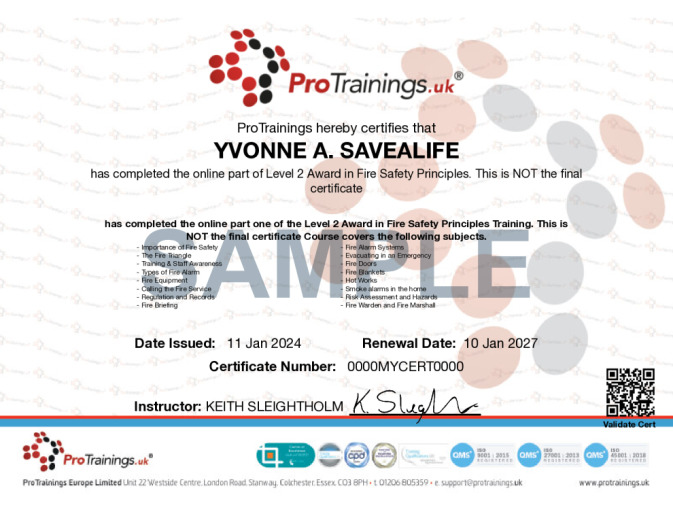TQUK Level 2 Award in Fire Safety Principles (RQF)
Understand the importance of managing fire safety protocols in your workplace.
TQUK Level 2 Award in Fire Safety Principles (RQF) at a glance
- 3-year nationally recognised certificate
- 2 hours and 3 minutes of engaging video training
- Video access for 8 months
- Printable wall certificate
- Free weekly video refresher
- Videos include subtitles
The TQUK Level 2 Award in Fire Safety Principles (RQF) course is a regulated qualification which sits on the Ofqual Framework. This course is designed for managers, supervisors, team leaders, fire wardens/marshals, staff or anyone working in an area where there is a potential risk of fire.
This qualification is designed to meet and comply with the Regulatory Reform (Fire Safety) Order 2005. It covers how fires are started, methods of controlling fire spread, evacuating the building, fire briefings and risk assessing.
Online e-Learning:
The theoretical components of this course have been neatly collated into bite-size modules, where you can watch a variety of videos, review scenarios and answer questions between each module. You will then need to complete 2 tests to be awarded the full TQUK Level 2 Award in Fire Safety Principles (RQF) certificate - the online video e-Learning MCQ test and the open response assessment as mentioned below.
Assessment: you are required to complete an open response theoretical assessment ensuring you meet all the command verbs during this written assessment. You must contact the compliance department (click here) to request a copy of the assessment.
Classroom option:
Complete this qualification through traditional classroom training with one of our approved instructors or as a virtual training live with an instructor through Zoom or similar using our remote platform. Gain the same regulated qualification whichever option you choose.
A regulated TQUK Level 2 Award in Fire Safety Principles (RQF) certificate will be generated following the completion of your e-Learning, classroom session and open response assessment.
Those gaining this qualification will know that fire safety is the responsibility of everyone in the workplace and will recognise the consequences of a fire on any premises.
Please be advised this course has a minimum age requirement of 16.
This course gives learners the opportunity to gain a formally recognised regulated qualification. If you require funding, a regulated qualification is often required. Phone us and we can advise if needed. If you choose our course leading to a regulated qualification, there are additional assessment criteria to be undertaken with an instructor and a small extra certification charge.
- Fire Wardens
- Fire Marshals
- Responsible Persons in workplaces
- Responsible Persons in Buildings
- Managers
- People wanting a higher level of Fire Training
This course comes with 6.0 hours of CPD, although the time to complete the course online may be less than this. Total course time includes 2 hours and 3 minutes of video training as well as knowledge reviews, final test, remedial help and reviewing downloaded material.
- Explain how fires are caused in the workplace
- Describe the components of the fire triangle
- Identify the hazards during or after a fire, including the products of combustion
- Describe the characteristics of fire and smoke spread
- State the different methods used to identify and control fire hazards
- Define the term 'means of escape' in relation to fire hazards
- Outline typical components for means of escape from fire hazards
- Describe methods of fire detection and raising the alarm
- Describe the principle of how fires are extinguished
- Describe how portable fire-fighting equipment should be used safely
- Identify common fixed fire-fighting systems and where they might be used
- Outline the duties of employers and employees with respect to fire safety in the workplace
- Outline how to undertake a simple fire safety inspection in the workplace
- Describe the stages involved in a fire risk assessment
- State the role and function of fire wardens in their workplace: on a day-to-day basis, during an emergency and if they are not in their designated areas of responsibility when the alarm is raised
- Outline the content of a fire safety briefing
Learning Outcomes:
1 Understand the hazards and risks associated with fire in the workplace
1.1 Explain how fires are caused in the workplace
1.2 Describe the components of the fire triangle.
1.3 Identify the hazards during or after a fire, including the products of combustion.
1.4 Describe the characteristics of fire and smoke spread.
2 Understand how fire risk is controlled in the workplace
2.1 State the different methods used to identify and control fire hazards.
2.2 Define the term ‘means of escape’ in relation to fire hazards.
2.3 Outline typical components for means of escape from fire hazards.
2.4 Describe methods of fire detection and raising the alarm.
2.5 Describe the principle of how fires are extinguished.
2.6 Describe how portable fire-fighting equipment should be used safely.
2.7 Identify common fixed fire-fighting systems and where they might be used.
3 Understand the principles and practice of fire safety management at work
3.1 Outline the duties of employers and employees with respect to fire safety in the workplace.
3.2 Outline how to undertake a simple fire safety inspection in the workplace.
3.3 Describe the stages involved in a fire risk assessment.
4 Understand the role of the nominated fire warden
4.1 State the role and function of fire wardens in their workplace:
On a day-to-day basis
During an emergency
If they are not in their designated areas of responsibility when the alarm is raised.
4.2 Outline the content of a fire safety briefing.








